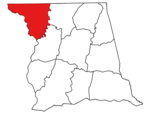Chapel Hill Church Tabernacle
19th-century Methodist church buildings in the United StatesBuildings and structures in Davidson County, North CarolinaChurches completed in 1870Churches on the National Register of Historic Places in North CarolinaDavidson County, North Carolina geography stubs ... and 4 more
Methodist churches in North CarolinaNational Register of Historic Places in Davidson County, North CarolinaPiedmont Triad region, North Carolina Registered Historic Place stubsTabernacles (Methodist)
Chapel Hill Church Tabernacle is a historic Methodist church tabernacle located near Denton, Davidson County, North Carolina. It was built in 1870 and enlarged in the 1920s. It is a one-story, heavy-timber, open-framework building, open on three sides. It has a concrete floor and a gable-on-hip roof. The tabernacle was originally used for the religious services at the annual camp meetings. The tabernacle is located on the grounds of Chapel Hill United Methodist Church, whose congregation dates from 1854.It was added to the National Register of Historic Places in 2012.
Excerpt from the Wikipedia article Chapel Hill Church Tabernacle (License: CC BY-SA 3.0, Authors).Chapel Hill Church Tabernacle
Chapel Hill Church Road,
Geographical coordinates (GPS) Address External links Nearby Places Show on map
Geographical coordinates (GPS)
| Latitude | Longitude |
|---|---|
| N 35.553611111111 ° | E -80.071111111111 ° |
Address
Chapel Hill Church Tabernacle
Chapel Hill Church Road
27239
North Carolina, United States
Open on Google Maps




